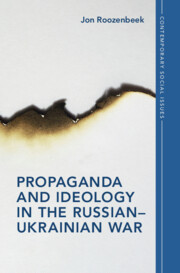Book contents
- Propaganda and Ideology in the Russian–Ukrainian War
- Contemporary Social Issues Series
- Propaganda and Ideology in the Russian–Ukrainian War
- Copyright page
- Contents
- Figures
- Maps
- Tables
- Acknowledgements
- Note on Transliteration
- Abbreviations
- Maps
- Introduction
- 1 A History of Russian–Ukrainian Relations
- 2 The Politics of the Donbas ‘Republics’
- 3 Building a Propaganda Machine
- 4 Newspaper Narratives in Occupied Ukraine
- 5 Identity and Ideology in Online Media
- 6 The Consequences of Propaganda
- Concluding Remarks
- Appendices
- References
- Index
3 - Building a Propaganda Machine
Published online by Cambridge University Press: 16 May 2024
- Propaganda and Ideology in the Russian–Ukrainian War
- Contemporary Social Issues Series
- Propaganda and Ideology in the Russian–Ukrainian War
- Copyright page
- Contents
- Figures
- Maps
- Tables
- Acknowledgements
- Note on Transliteration
- Abbreviations
- Maps
- Introduction
- 1 A History of Russian–Ukrainian Relations
- 2 The Politics of the Donbas ‘Republics’
- 3 Building a Propaganda Machine
- 4 Newspaper Narratives in Occupied Ukraine
- 5 Identity and Ideology in Online Media
- 6 The Consequences of Propaganda
- Concluding Remarks
- Appendices
- References
- Index
Summary
This chapter traces the development of the Donbas media landscape after the emergence of the ‘People’s Republics’ of Donetsk and Luhansk (DNR and LNR) in 2014. It focuses on the DNR/LNR authorities’ efforts to first break down and then rebuild local media. These efforts consisted of two phases: one of destruction and one of reconstruction. The destruction phase involved tearing down the existing media structure and pressuring journalists into either leaving Donbas or cooperating with the new authorities. The reconstruction phase involved setting up new media channels or repurposing existing ones, as well as implementing new legislation to impose censorship and promote certain desired narratives. The ministries of information of the two ‘Republics’ promoted local media production and set limits to what was allowed to be published by implementing accreditation procedures and keeping track of journalists working in the region. This formalisation occurred through a system of laws, decrees, edicts, and other regulations.
- Type
- Chapter
- Information
- Propaganda and Ideology in the Russian–Ukrainian War , pp. 49 - 64Publisher: Cambridge University PressPrint publication year: 2024

